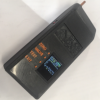Nanoparticle concentration detector
Technology description
| The name of the technology: | Nanoparticle concentration detector |
|---|---|
| Challenge: |
The presence of nanoparticles in the air, i.e. particles of indeterminate shape loosely defined as less than 100 nm in size, can pose a serious risk to human health. Inhaled nanoparticles, particularly those of a size of up to a few tens of nm, have a relatively high probability of being trapped in the lung chambers from which they can enter the bloodstream. Vehicle internal combustion engines are an important source of nanoparticles, which result in high concentrations of nanoparticles in outdoor air, particularly around busy traffic routes. Recently, however, various types of industrially produced nanoparticles have also become increasingly important and may thus be present not only in the outdoor environment but also in workplace interiors. Current devices based on smoke detector designs can detect high concentrations of particles in fires from the start, they are not however suitable for quantitative measurement of nanoparticles. |
| Description: |
The measurement of the concentration of nanoparticles in the working environment is carried out using an ionization chamber in which nanoparticles of extremely small size, i.e. significantly smaller than the wavelength of visible light, are detected. This allows the detection of concentrations of nanoparticles harmful to human health, while achieving objective results with high measurement reliability. Main advantages - High sensitivity of quantitative measurements. - Detection of concentrations of nanoparticles harmful to human health, including nanoparticles of extremely small size. - Compact portable device weighing up to 1 kg. - Low production costs (approx. CZK 10 000). |
| Commercial opportunity: | Commercial applications include real-world automotive applications for controlling ultrafine particle emissions or occupational exposure in nanoparticle handling operations. |
| IP protection status: | CZ patent CZ307891 |
| Development status: |
Phase 3Corresponds with TRL 5 and TRL 6 Technology validation and implementing it in real environment. Testing the technology outside of the laboratory and its adjustment to external conditions.
|
| Partnering strategy: | licensing |
| More information: | Chráněno patentem CZ307891 a užitným vzorem PUV32414. |
| Images: | |
| Categories: | Nanotechnology Physics |
| Owner of a technology: |


